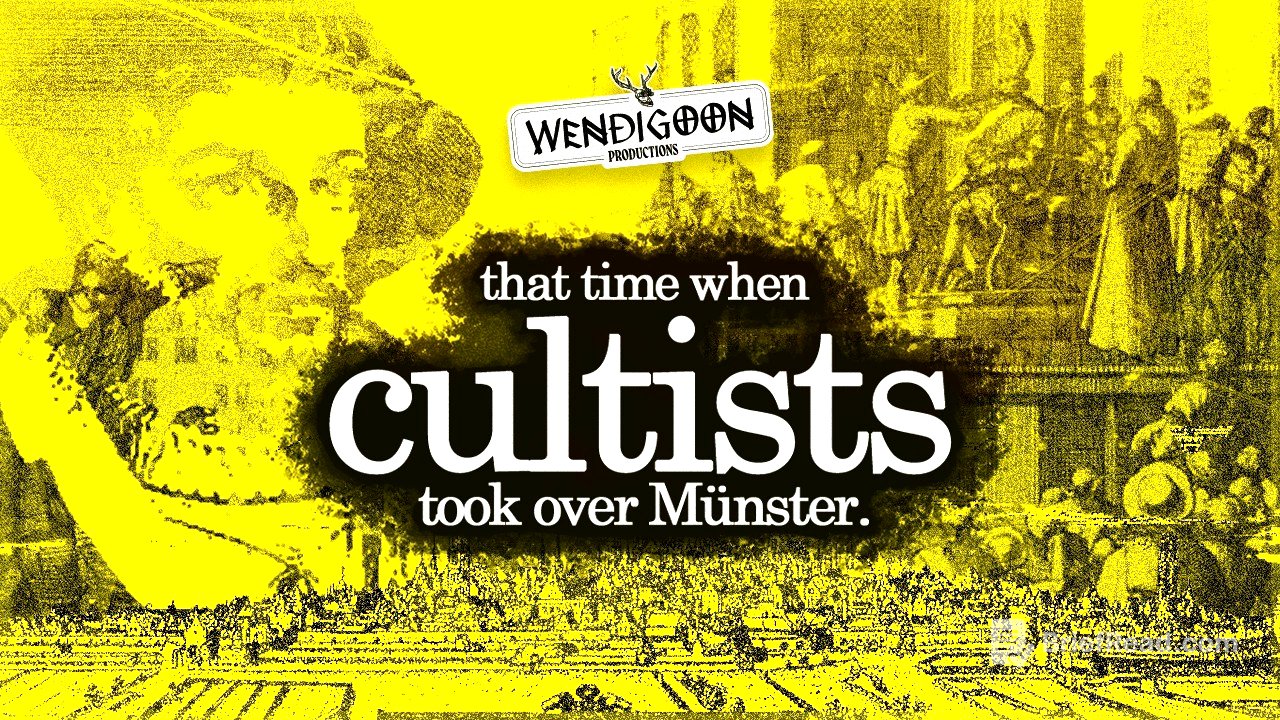TLDR;
This video discusses the Moonster Rebellion, a radical Anabaptist movement that took over the city of Münster in the 16th century. It explores the historical context of the Holy Roman Empire and the rise of Anabaptism, detailing the events leading to the rebellion, the key figures involved, and the horrific consequences of their rule. The rebellion transformed Münster into a theocratic military dictatorship, marked by violence, communal living, and the eventual siege and recapture of the city, culminating in the gruesome executions of its leaders.
- The Holy Roman Empire's political structure and the rise of Protestantism and Anabaptism set the stage for the rebellion.
- Key figures like Melchior Hoffman, Jan Matthys, and Jan van Leiden shaped the events in Münster.
- The rebellion led to extreme violence, communal living, and a theocratic military dictatorship.
- The siege of Münster resulted in starvation, cannibalism, and mass executions.
- The rebellion ended with the city's recapture and the gruesome executions of its leaders, whose cages still hang on St. Lambert's church today.
Introduction to the Moonster Rebellion [0:00]
The video introduces the topic of the Moonster Rebellion, a historical event where a religious movement seized control of a medieval European city. The speaker expresses his excitement to share the story, which involves a zealous leader, public executions, and the gruesome fate of the leader's body parts. The Moonster Rebellion is portrayed as a unique and disturbing event in religious history.
The Holy Roman Empire and the Rise of Anabaptism [3:21]
To understand the Moonster Rebellion, it's important to know about the Holy Roman Empire in the 16th century. The Holy Roman Empire was a loose confederation of lords, kings, and villages that revered the Catholic Church. In 1517, Martin Luther challenged the Catholic Church, leading to the rise of Protestantism. Around 1525, the Anabaptists emerged, differing from both Catholics and other Protestants by rejecting infant baptism and advocating for believers baptism. This rejection was significant because infant mortality rates were high, and the church saw baptism as essential for salvation. Anabaptists also opposed power structures, advocated for communal ownership of goods and land, rejected secular government, and embraced pacifism, clashing with the Catholic Church and ruling classes.
From Straussburg to Moonster: The Stage is Set [8:45]
The story begins in Straussburg, where Melchior Hoffman declared himself one of the two witnesses from the Book of Revelation, prophesying Jesus's return in 1534. Authorities arrested Hoffman, but his followers continued to believe in his prophecies, seeking a new Jerusalem. Meanwhile, in Moonster, former Catholic priest Bernard Rothman embraced Anabaptist beliefs, advocating for equality of ownership and rejecting hierarchies. Rothman's radical ideas gained support, especially after the German Peasants' War, and people flocked to Moonster. Rothman's ally, Bernard Nipperdoling, used his printing press to spread Rothman's sermons, attracting Hoffman's followers, now led by Jan Matthys, who declared Moonster the new Jerusalem. Matthys and his second-in-command, Jan Van Leen, prepared to take their followers to Moonster.
The Takeover of Moonster [15:53]
In early 1534, Matthys and Van Leen arrived in Moonster, which was already experiencing religious and social upheaval. Van Leen's theatrical preaching caused hysteria, leading Anabaptists to seize the town hall and declare Moonster open to all Anabaptists. Matthys, unlike Rothman, favored violence to win people over. On February 25th, Matthys declared that Moonster must be cleansed of the unrighteous, ordering the execution of non-Anabaptists. Nipperdoling convinced Matthys to instead expel non-believers, leading to a mass expulsion on February 27th. Those who remained were forcibly rebaptized, and their belongings were collected, furthering the radical transformation of Moonster.
Life Under Matthys's Rule [20:36]
After expelling non-Anabaptists, Matthys implemented a system of communal ownership, collecting all belongings and redistributing them based on need. Rothman supported these actions through his sermons. Opposition was met with violence, exemplified by the public execution of a blacksmith who accused Matthys of being possessed. On March 15th, Matthys ordered the burning of all non-biblical religious texts. Prince Bishop France von Waldick, the ruler of Moonster, responded to the chaos by building an army of mercenaries to retake the city, leading to a siege. Matthys, Van Leen, Rothman, and Nipperdoling manipulated the siege to their advantage, transforming Moonster into a theocratic military dictatorship.
Matthys's Failed Miracle and Van Leen's Ascension [25:48]
On Easter Sunday, April 5th, 1534, Matthys claimed God would smite the enemy armies through a miracle, leading himself and 30 men to charge the prince bishop's army, resulting in their brutal slaughter. Matthys's head was placed on a pike, and his genitals were nailed to the city gate. Van Leen stepped up, declaring Matthys's death a sacrifice and himself the new David, the steward until Christ's return.
The Defense of Moonster and Van Leen's Reign as King [29:29]
In May 1534, Waldick's armies surrounded Moonster, planning an attack. However, on May 25th, a unit of drunk mercenaries prematurely attacked the city in the dark, leading to a disastrous defeat for the bishop's forces. The people of Moonster celebrated this miraculous win. Van Leen used this victory to solidify his power, declaring Moonster the New Jerusalem and himself the king of earth until Jesus's return. In September 1534, Van Leen held a coronation, adopting the motto "God's power is my strength." Law and order dissolved, replaced by Van Leen's whims, and Moonster became a cult compound.
Terror and Starvation in Moonster [36:03]
Under Van Leen's rule, Moonster became a place of terror. He reprised the Ten Commandments with capital punishment, and dissent was met with public beatings and executions. Polygamy was mandated, and Van Leen took at least 16 wives. Meanwhile, Prince Bishop Waldick's siege tightened, leading to starvation within the city. People resorted to eating animals, rats, and even shoe leather. Van Leen, however, continued to hold banquets for his court, preaching that their suffering was a sign of their faithfulness. A surveillance state emerged, with secret police enforcing Van Leen's will.
Desperation and Defection [41:46]
As starvation worsened, people ate mice, slugs, and bark off trees, and some resorted to cannibalism. Many tried to escape the city, only to be gunned down by the prince bishop's armies. Some strategically defected, providing information to the prince bishop's forces. A rumor spread that Van Leen planned to burn down the city if it were to fall.
The Fall of Moonster and the Fate of Its Leaders [46:16]
On June 24th, 1535, the prince bishop sent 400 soldiers to covertly invade Moonster, using defectors to guide them. The soldiers slaughtered the starving masses, capturing Van Leen, Nipperdoling, and Cretching. After the fall of Moonster, the prince bishop executed many, including women who refused to renounce their faith. The walls of Moonster were destroyed to prevent future rebellions. Van Leen and his lieutenants were paraded throughout the Holy Roman Empire before their gruesome executions.
The Gruesome Executions and Lasting Legacy [51:21]
On January 22nd, 1536, Van Leen, Nipperdoling, and Cretching were publicly tortured and executed in Moonster. They were shackled to stakes and had their flesh torn apart with red-hot tongs for an hour before being killed. Their bodies were placed in iron cages and hung from St. Lambert's church, where the cages remain to this day. The Moonster Rebellion became synonymous with fanaticism and heresy, serving as a prototype for cults in the centuries that followed. The speaker reflects on the tragic irony of people seeking a better life only to suffer such a horrific fate.









